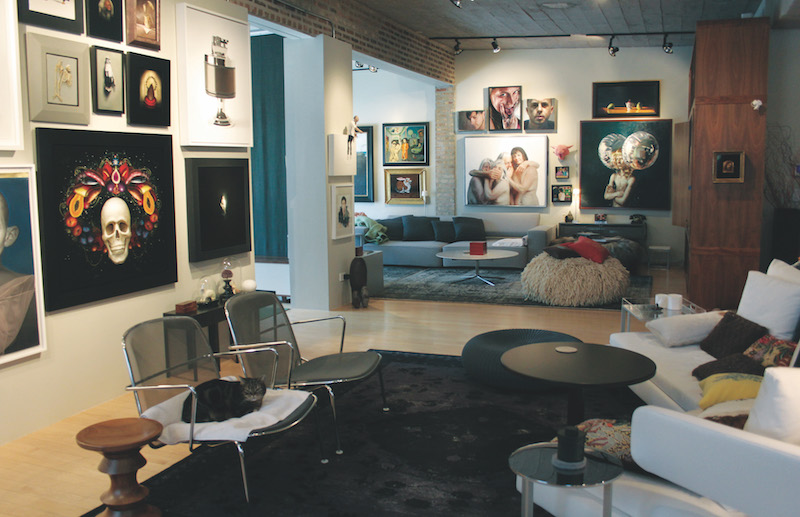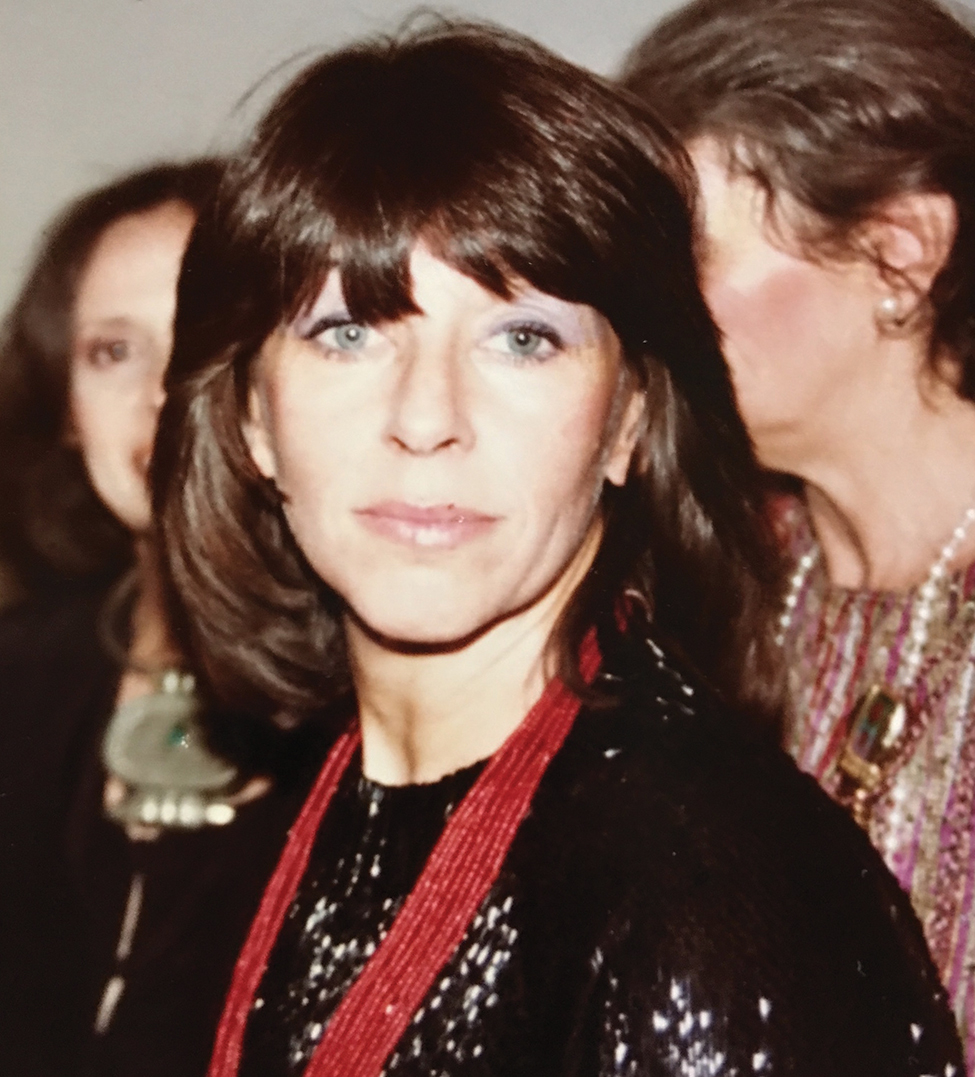Building a Home for Art: Reviving an Industrial Space in Ravenswood


By GINNY VAN ALYEA
During one of Chicago’s very snowy days this winter, I made my way down a quiet North Side block blanketed in white and pulled up to an industrial looking building that, from the outside, I wasn’t quite sure was the right address. I knew only that I was supposed to visit collectors at their Ravenswood residence. I peeked into a side window and saw someone at a desk jump up to meet me at the door, and a moment later Brian Westphal and Michael McVickar invited me out of the snow and into their art-filled home.
After shedding my down-filled layers and meeting the couple’s cats, we first enjoyed some gourmet coffee prepared in a hidden, designer prep space just off of the kitchen. The story of how Brian and Mike’s home came to be was on my mind as soon as I walked in. While the walls are filled with dozens of contemporary paintings and other works of art, the character of the open, ground floor space is also largely defined by its industrial bones, since the building once housed a motor oil company.
The couple gutted and rehabbed their previous home, a worker’s cottage in Roscoe Village. According to Mike, “It was a beautiful little house, but it was on a smaller than normal city lot. We basically still had this list of things that would be nice to have.”
One day, when Mike was looking through The Chicago Reader real estate section, he noticed an ad for a small factory building for sale in Ravenswood. The listing, he recalls, had bells and whistles that both he and Brian wished their existing house had.
“So,” Mike remembers, “I said let’s just go check it out. We called our realtor and came over for a look. Basically it was just a brick box.” The building was two stories, with the first floor totally open and without a kitchen. It had also been neglected. Open windows had let in water, which led to moldy floors. The walls that did exist didn’t go to the ceiling. Because the previous owners had left Chicago and not kept a close eye on things, the space had also been broken into. Graffiti tags were spray painted on the concrete pillars on the first floor.

Mike adds, “It was kind of a hard living space. We walked out, and I said, ‘No way in hell are we buying this place and leaving our really nice, finished little house.”
Brian remembers it differently, “He didn’t say that.”
“Yes I did,” counters Mike. “Brian was the one who said it was perfect and that we could do so much with it.”
Eventually, of course, they did buy the building. Brian saw promise in the larger lot size and the yard. Even though there was nothing there yet, he says, “It was just grass, but it was clearly a cool space.”
Mike admits, “Had we not previously been through a whole house construction project, I would have run out the door. But we did understand that we could probably get it to look like we wanted.”
Though the project did seem daunting, a previous owner had originally purchased the property intending to live there. They cleaned up the environmental issues, such as a tow truck in the yard and old storage tanks, which were still present once the factory had closed. By the time Brian and Mike came along, the building had a new roof, as well as a new heating system and windows. They were able to move in and live in the space for a while as they began the work of putting in the first floor kitchen, as well as bathrooms and rooms upstairs. They maintained the original open floor plan and kept concrete ceilings, but they covered up some of the exposed brick in order to hang art and simplify the look of the space.
Brian and Mike began buying art together long before embarking on their home renovation. As Mike recalls, “It was a natural evolution. First we had posters, and then Brian started buying some finer framed things.”
Brian tells Mike, “You actually said, ‘I don’t want to hang a bunch of posters on the wall.’ And since we had had a good friend of ours stay with us, and he had been collecting art –”
“Yes,” finishes Mike, “He was the first person we knew who had art. That opened the door for us to see that real people do actually buy these things.”
Those regular encounters through their friend got Mike and Brian to think that they could also learn about and buy art that they loved. For Brian, he admits that they began to understand they valued their friend’s art because it made them ask questions. They were constantly curious about what it was and what made it stand out to them.
The next step to discovering art on their own meant visiting galleries. Though they acknowledge that galleries seemed intimidating at first, mostly due to their own inexperience, as well as what they recall as sticker shock, they slowly got to know a few established dealers, such as River North veteran Ann Nathan, and little by little they overcame what Mike considers initial hurdles. Victor Armendariz, who worked with Nathan for many years, told the couple when they were starting to buy that once they got into it, they wouldn’t be able to stop, something that they now know to be absolutely true.
“There was a piece by Jeffrey Kamberos,” says Brian, “that we had seen at least a year before we bought it, and it just so happened that it never sold. We kept talking about the piece, and after a year, we thought, ‘We obviously want this painting,’ so we finally bought it and, as Victor warned, it’s been downhill ever since.”
Standing in Mike and Brian’s living room, I sensed many pairs of eyes on me. Looking around I noticed many different faces and bodies in the art on view. Much of the work that the couple collects is figurative, which explains their early interactions with dealers like Nathan and Armendariz, as well as William Lieberman, who each represent many figurative artists.
As Mike explains, “We were definitely drawn to figurative work.” Brian adds that they didn’t set out with an exclusive collecting focus, but rather it revealed itself as a dominant draw over time. Eventually the pair decided that narrowing their collecting focus would help further develop their taste.
Eventually both Brian and Mike had to acknowledge that they had gone beyond casual art buying. “It took me a while to say I am a collector,” admits Brian. For Mike, the label came almost out of a necessity to define their role in the art world, “Well, people will ask, ‘Are you an artist or a collector?’ So, you kind of end up owning the term collector, because we are not artists,” he says.
Like other collectors in Chicago I have had the pleasure of interviewing, Brian shares a familiar sentiment about a life with art, “We buy what we love and we love to live with it, so that’s why we do it.” For Mike as well, he says they are not really trying to amass a collection of anything. He emphasizes, “I mean, it really just happens.”
Brian and Mike continue to spend plenty of time visiting galleries and art fairs, but they also acknowledge the ease, as well as the pitfalls, of having so much art available online. For Brian, “These days its much easier with everything being online, since you can easily see and find lots of work. On the other hand you don’t have to go out as much. It’s become like anything else – it’s sort of an Amazon.com world.”
They do still go to galleries, though they confess not as much as they used to. It’s a little awkward to admit, but Brian says, “We used to go a lot more.”
Despite the lure of the comforts of home, the social aspect of the art community cannot be obliterated by the Amazonification of everything. Mike explains, “We like seeing the gallerists and artists, we like running into other collectors. It’s the people who really draw us out.”

Now the couple says they average at least one purchase a year, their most recent being a porcelain, multimedia piece by Rodrigo Lara Zendejas. Mike interjects, “We had a party here, and we had just gotten this piece that day. William [Lieberman] and Brian [Gillham] from the gallery [Zolla/Lieberman] had told us they were going to come up sometime to help us hang it, but they came to the party and put it up right then. It was a fun example of how so many things come together in the art world.”
When explaining what it is about figurative work that appeals to each of them, Mike says, “It comes down to the fact that I just don’t get abstract art. I can understand some of it, but I just find it kind of esoteric that you have to go in and you have to learn. It’s not a bad thing to have to learn the artist’s perspective of course, but I want to look at something and be able to form a narrative on my own.”
Brian gets to the point: “We don’t ultimately care whether there is a meaning behind these pieces. People come over and ask me, ‘What’s this about?’ Well, we don’t know. I usually say it’s whatever you want it to be. But for us there’s resonance to seeing people, rather than the abstract.”
To Mike, art is primarily visual, and it should be personally appealing, “It can be beautiful to you or not. Maybe sometimes it gets more beautiful the more you look.” He sees the attraction like a relationship, one that in order to last must go deeper than a first impression. For Mike and Brian, art must also defy its surroundings. As Mike puts it, “I just can’t stand hearing people say something like, “Where am I going to put that? Will it fit over the sofa? That’s not why you buy a piece of art.”
Talking more about why exactly you do buy a piece of art, Brian and Mike went back and forth about how their own collecting journey might look to a younger generation that has been adamant about seeking experiences over things. Reflects Brian, “To me these paintings are not things, they are not objects you are going to use for a while and either dispose of, or just upgrade, later. These are things you want to live with, so in a way they are experiential because every time you walk into the room you know you are affected by what they do to you in this space.”

Mike is enthusiastic about the uniqueness art brings to his day-to-day routine. “I love that I’m the only one in the world that has that painting by that artist,” he says, pointing to a striking scene of a cluster of older, nude women embracing each other and laughing, like they’re sharing secrets while posing for a candid photo in school days. He explains, “That’s an interesting piece – it’s a very inviting and realistic portrayal of these aging women together. One of them is the artist’s mother, and the others are her family friends. It was kind of a woman-power thing, years ago before all the stuff people have been addressing now. The artist, Aleah Chapin, is an amazing person. To me it’s the whole package.”
Brian and Mike first saw Chapin’s work at the New York Academy of Arts several years ago. After wandering through the various spaces and seeing work by first and second year students in various stages of progress, they noticed a painting that a young artist who was getting her MFA, Chapin, was working on. Some time later, Brian saw another piece of Chapin’s become available through Flowers Gallery in London. The couple decided to buy it, since it had been on their minds all that time. A few months later she was announced as a finalist for the 2012 BP Portrait Award in London, and eventually she was named the winner for the piece that Brian and Mike had seen back at NYAA. “The prices for her art went through the roof, if you could even get them,” says Brian. “We loved the piece we bought, number one, and we wanted it for that reason, but it’s fun to think we did a good job identifying it early on. I’m delighted that we have this in our house.”
For Mike, he says he loves the back-story about the painting’s subjects as well as the tale of how they found it, but ultimately he just likes how it looks. “It’s great to have that history behind the painting, but I don’t need that to appreciate this. That’s what I think I miss in abstract art – I feel like I can’t appreciate it unless I always know everything about the artist and all the elements of the work. For me hopefully any one of these works [at home] stands on their own. You can love or hate it, but you don’t necessarily need to know the details to really appreciate it.”
Brian agrees, “There’s enough art out there for everybody. You can pick your own style and decide what you like. For us, this is what we love.”







